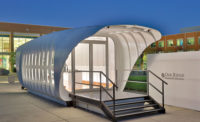The move of the Whitney Museum of American Art from its Marcel Breuer'designed quarters on Manhattan's Upper East Side to the city's Meatpacking District presented a host of challenges, flooding among them. The museum knew that the new downtown site—sandwiched between the Hudson River and the increasingly popular High Line—would be at risk in an intense storm. That's one of the reasons why the building's architects, Renzo Piano Building Workshop (RPBW) and Cooper Robertson, opted to locate the permanent galleries and art storage for the recently opened museum in the upper reaches of the eight-story structure. It is also why they raised the lobby a foot and a half above the 500-year-flood plain.
But when Hurricane Sandy slammed New York in October 2012, while the new museum was under construction, the storm surge brought more than 6 million gallons of river water into the basement. Although the building was already framed to the fifth-floor level (making it impractical to radically rethink the design), the project team insists that the event provided an opportunity in disguise. “We were lucky it happened when it did,” says Tom Wittrock, a Cooper Robertson partner.
Sandy was the impetus for the museum to seek the help of a German team of engineers—WTM, which has a specialty in port and marine structures—along with experts in storm modeling from the Franzius Institute at the Leibniz University of Hanover. They came up with a plan for protecting the museum up to 16.5 feet above the Manhattan Datum—a level 6.5 feet higher than the lobby floor and more than 5 feet higher than Sandy's floodwaters. They accomplished this with strategies that should go unnoticed by visitors.
For example, the loading-dock entry, which sits at street level and faces the river, is protected by a 27-by-14-foot hinged floodgate. Made by a fabricator of watertight doors for naval vessels, the 8-inch-thick steel door, weighing approximately 15,000 pounds, requires two people to close it.
One of the Whitney's most vulnerable features is the lobby, which is enclosed by floor-to-ceiling glass on three sides. Here the engineers devised a deployable watertight barrier of stackable aluminum “logs.” If a severe storm is predicted, a crew of 20 workers can erect the temporary wall in about 7 hours. The demountable nature of the barrier preserves a key aspect of the design: “The idea was to create an open and transparent ground floor and treat the outside and inside as one,” explains Elisabetta Trezzani, an RPBW partner. The lobby, she says, was conceived as a “big piazza for the city.”
The Whitney is not the only art museum that has grappled with flood mitigation. Just one of several such institutions is Herzog & de Meuron's Perez Art Museum Miami, which sits on the edge of Biscayne Bay. To protect the three-story glass and concrete building and its art exhibits from storm surge, the architects raised it above sea level on a plinth, with the space below dedicated to parking.
But in addition to water, the other severe weather threat that the Perez design team had to consider was hurricane-force wind, and any material it could carry with it. To safeguard against damage in an intense storm, the impossibly thin-looking concrete piloti that support an expansive trellis have been heavily reinforced to withstand both lateral forces and the impact of wind-borne debris. The suspension and irrigation systems for the hanging gardens, designed by green-wall pioneer Patrick Blanc, have also been carefully braced.
Arguably, the Perez's most notable hurricane-resistant features are its windows, the largest of which span 7 feet 6 inches between their ultra-high-performance reinforced concrete mullions and 17 feet 3 inches from slab to slab. By code, the double-glazed units were required to undergo a battery of tests, including a so-called “missile impact test.” This entails firing an 8-foot-long two-by-four at a speed of 50 feet per second at the glass assemblies. The Perez windows are said to be the largest so far to undergo this testing regimen in the U.S.
The code dictates that the missile-impact test must be conducted by an independent laboratory. But the project's facade contractor, Seele, opted to perform its own “pretesting” in its glass-fabrication facility in Germany in order to help determine the optimal glazing assembly. Ultimately Seele settled on an outer lite of two layers of 12 millimeter heat-strengthened glass and an inner one of two layers of 8 millimeter fully tempered glass. Both included a reinforced PVB interlayer.
Results from the company's pretesting of the glazing system were consistent with the official preconstruction test subsequently performed in a lab in York, Pennsylvania. In both instances, the two-by-fours caused significant damage to the unit's outer lite, while the inner one remained intact, as the code mandates. The inside layers of glass are considered the last line of defense. “They are sacrosanct,” explains Bruce Nichol, a partner with Front, the project's facade consultant, while the outer lite is thought of as “sacrificial,” he says.
The Perez has yet to undergo a real-life test. The storm seasons since its opening in late 2013 have been unusually calm, notes interim director Leann Standish. But that doesn't mean that she and her staff are just waiting for the next one to hit. Annually, they reevaluate their emergency procedures, including plans for moving or securing the regularly changing outdoor sculpture. “The only good thing about a hurricane,” she says, “is that you know it is coming.”
|
Continuing Education
 To earn one AIA learning unit (LU), including one hour of health, safety, and welfare (HSW) credit, read the three stories in the "Water and Resilience" section: "New Orleans Goes with the Flow"; "Befriending the Floods"; and "Flirting with Disaster". Then complete the test at architecturalrecord.com. Upon passing the test, you will receive a certificate of completion, and your credit will be automatically reported to the AIA. Additional information regarding credit reporting and continuing-education requirements can be found online at continuingeducation.bnpmedia.com. To earn one AIA learning unit (LU), including one hour of health, safety, and welfare (HSW) credit, read the three stories in the "Water and Resilience" section: "New Orleans Goes with the Flow"; "Befriending the Floods"; and "Flirting with Disaster". Then complete the test at architecturalrecord.com. Upon passing the test, you will receive a certificate of completion, and your credit will be automatically reported to the AIA. Additional information regarding credit reporting and continuing-education requirements can be found online at continuingeducation.bnpmedia.com.
Learning Objectives
1 Explain how green infrastructure can be used to bolster traditional hard infrastructure for flood control. 2 Describe how green infrastructure tactics can be used to remove pollutants from stormwater. 3 Discuss measures implemented by two recent art museums as protection from flooding. 4 Outline the testing regimen for hurricane-resistant glazing. AIA/CES Course #K1507A
For CEU credit, Read “Water and Resilience” and take the Quiz at continuingeducation.bnpmedia.com, or use our architectural record continuing-education app, available in the itunes store.
|















Post a comment to this article
Report Abusive Comment